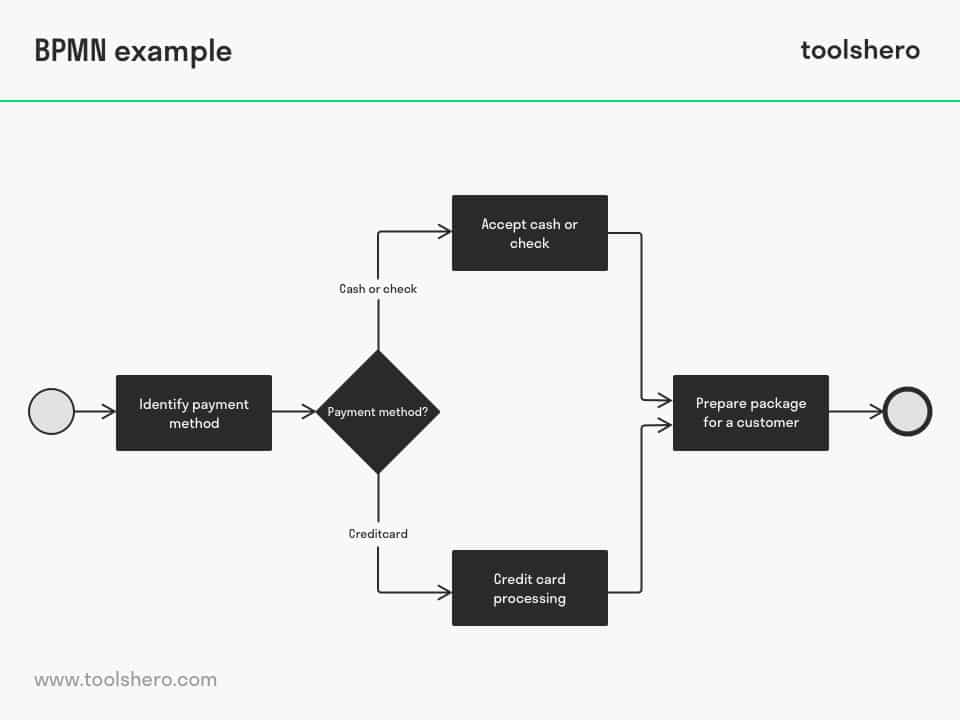Business Process Modelling Notation (BPMN)

Business Process Modelling Notation (BPMN): this article explains the concept of BPMN or Business Process Modelling Notation in a practical way. The meaning of BPMN is discussed and how processes can be drawn in a model. Then an example of a diagram is given, followed by an explanation of the symbols and how time can be saved. After reading you will understand the basics of this IT technique for modeling business processes. Enjoy reading!
What is BPMN?
Every organisation has to deal with business processes. Regardless of whether it concerns a profit or non-profit organisation. Business processes occur wherever people work. All these processes consist of activities, tasks and decisions that are carried out to realise an organisation’s objectives.
Business Process Modelling Notation (BPMN) is concerned with the formal recording and improvement of these existing business processes. The goal of BPMN is to visualise these processes. Currently, the method has been standardised and is now usually referred to as Business Process Model and Notation.
By drawing existing processes, an accessible standard is created that is managed by the independent Object Management Group (OMG). BPMN is an IT tool to implement Business Process Management.
Drawing Processes
BPMN offers an organisation simple and insightful process models. Processes take place on various levels; from strategic, tactic to operational level. By describing the processes in steps in great detail, it becomes clear what each department or individual employee must do and which actions this includes.
It’s possible to draw all these various processes within BPMN, offering more insight into the goings-on of the organisation. This drawing is referred to as modelling. Process analysts can add details to the process. IT specialists can also use the results for implementation in an automated environment.

Figure 1 – an example of a BPMN flow
To work with BPMN, organisations must first purchase software for modelling BPMN diagrams. It’s important that all processes are automated in this way and that all interested parties understand, read and interpret the process models in the same way.
Think of various parties that are involved in those business processes, such as process owners, managers, business analysts, external consultants, architects, suppliers, system developers and users.
BPMN is an universal language
Because it must immediately be clear for all parties what the business processes are about, BPMN is an universal modelling language. BPMN allows an organisation to communicate with all stakeholders with only one process model per process. As a result, it helps organisations to model, optimise and carry out processes as effectively as possible.
A universal language ensures that business units in every layer of the organisation as well as IT can communicate more easily and understand each other. BPMN visualises process flows, actors, process steps and actions and is relevant for all parties that are involved in modelling and improving business processes.
In principle, BPMN is a flow chart method, in which all steps in a planned business process are mapped, beginning to end. This provides a detailed, visual overview of both the work methods and the flows of information of an organisation. Thanks to the simplicity, visual models and diagrams are often easy and quick to understand for everyone.
As a result, these facilitate a more efficient progression of business processes, which subsequently leads to better results. Employees don’t have to be IT specialists to work with BPMN. The basic principle of this method can be quickly learned and eventually, everyone is able to model processes.
BPMN Symbols
BPMN diagrams use various elements and symbols. BPMN consists of four basic elements with their own symbols: flow objects, connection objects, swim lanes and artefacts. Consequently, the essence of BPMN is comprehensible and easy and quick to work with. The four basic elements have been further specified. Below are the most frequently occurring symbols in business process diagrams, together with their specifications:
1. Flow objects
Events
A BPMN diagram starts with a motivation. Subsequently, adjustment or completion of the process follows. Events are represented by a circle. This circle contains other symbols based on their event type.
Activities
Within each event, certain activities take place that must be carried out by people or systems. The so-called tasks are represented in the shape of rectangles with rounded corners. The more sub-processes exist, the more detailed is the way in which these are represented.
Gates
A gate indicates a decision moment when a path can be changed. That makes it a transition based on certain conditions or events. These transitions or crossroads are shaped like a diamond.
2. Connecting objects
Sequence flows
Within BPMN, this indicates the order in which activities must be carried out. To indicate this, straight lines with an arrow are used.
Message flow
This represents the messages that flow across the various lanes in a ‘pool’; this refers to a department. In doing so, the message flow indicates the boundary between the various department within an organisation. However, the message flow is not used to connect events or activities to each other. The message flow is represented by an interrupted line, with a circle at the beginning and an arrow at the end.
Association
This creates a connection between an artefact (extra information from developers) or the description with an event, activity or a gate. An association is represented by a dotted line..
3. Swimming lanes
A pool or swim lane in BPMN represents a group of participants who are important to the business process. Multiple pools can represent both different businesses and departments that are involved in the business process.
Swim lanes display the activities and sequence and message flows for a specific participant. This makes it clear and insightful who is responsible for which part of the business process. Swim lanes are represented as rectangles or lanes.
4. Artefacts
This concerns extra information developers could add. This adds more details to the diagram. This concerns the following types of artefacts:
Data object
A data object shows the specific data required for an activity.
Group
A group displays a logical grouping of activities.
Annotation
An annotation provides more information about part of the diagram.
BPMN Saves time
BPMN is a rich standardised method, which both the organisation itself and the IT department can use. This does come with the condition that all parties involved make clear agreements on the meaning and use of the objects in the diagram.
After all, these agreements ensure that process models are uniform and can directly be understood by everyone. In this way, no misunderstandings can arise and BPMN can save a lot of time.
By subsequently describing all agreements and definitions in a BPMN convention manual, all parties know what to expect. Moreover, it indicates which constructions are preferred to depict specific process situations.
It would take a lot of time if this had to be investigated on every occasion. By referring to the convention manual, everyone knows what previous agreements have been made.
Now it’s your turn
What do you think? Do you recognize the practical explanation of BPMN or do you have more additions? Does your organisation make use of this technique to model business processes? What are the advantages or disadvantages of BPMN according to you?
Share your experience and knowledge in the comments box below.
More information
- Chinosi, M., & Trombetta, A. (2012). BPMN: An introduction to the standard. Computer Standards & Interfaces, 34(1), 124-134.
- Owen, M., & Raj, J. (2003). BPMN and business process management. Introduction to the new business process modeling standard.
- White, S. A. (2008). BPMN modeling and reference guide: understanding and using BPMN. Future Strategies Inc..
How to cite this article:
Mulder, P. (2019). Business Process Modelling Notation (BPMN). Retrieved [insert date] from Toolshero: https://www.toolshero.com/quality-management/bpmn/
Original publication date: 01/13/2019 | Last update: 06/13/2023
Add a link to this page on your website:
<a href=”https://www.toolshero.com/quality-management/bpmn/”> Toolshero: Business Process Modelling Notation (BPMN)</a>












